Science Highlights, December 14, 2016
Awards and Recognition
Explosive Science and Shock Physics
Quantifying detonation conditions upon high velocity fragment impact
Intelligence and Space Research
Unraveling cross-energy coupling in the Earth’s radiation belts with SHIELDS
Materials Physics and Applications
A new class of robust fuel cells based on ion-pair-coordinated polymers
Materials Science and Technology
Microstructural effects on damage evolution in shocked polycrystalline materials
Awards and Recognition
Daniel Livescu elected as an AIAA Associate Fellow
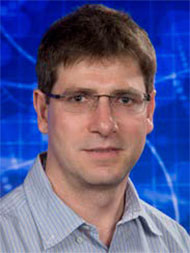
The American Institute of Aeronautics and Astronautics (AIAA) has selected Daniel Livescu (Computational Physics and Methods, CCS-2), scientist and fluid dynamics team leader, to be an Associate Fellow. Livescu is an authority in the field of fluid mechanics and has made significant contributions to the LANL/DOE Stockpile Stewardship mission as a Principal Investigator for the NNSA Defense Science Programs.
The AIAA cited him for “contributions to the fields of turbulence and mixing, and his contributions have spanned a range of technical areas relevant to fundamental fluid dynamics in various aerospace engineering applications. He has explored the physics of mixing between fluids in different densities in a variety of flows, and discovered that mixing at high-density ratios is asymmetric, with the heavy fluid mixing slower than the lighter fluid. Livescu’s finding has had consequences for fields such pollutant dispersion, and has led experts to rethink and update models based on single fluid or low-density ratio considerations. Livescu has also made contributions to the understanding of compressible turbulence, as well as proposing novel ways to study post-shock turbulence at higher Reynolds numbers and Mach numbers than thought possible before.”
Livescu received a Ph.D. in Mechanical and Aerospace Engineering from the University of Buffalo and joined the Lab in 2001. He is a world leader on direct-numerical simulation of turbulence and large-scale flow computations. Livescu has led open science projects, including on Lawrence Livermore National Laboratory’s Dawn and Sequoia supercomputers, and LANL’s Trinity and Roadrunner. He has performed the largest simulations to date of turbulent flows, approaching or exceeding the parameters achieved in typical experiments. The simulations have revealed new or unexpected physics and helped to develop LANL’s turbulence models. Livescu has mentored 12 postdocs and 11 Ph.D. students (as thesis coadvisor) over the last decade. He is also a Fellow of the American Society of Mechanical Engineers (ASME).
AIAA is the world’s largest aerospace professional society, serving more than 30,000 members from 88 countries, and 95 corporate members. The grade of Associate Fellow recognizes individuals who have accomplished or been in charge of important engineering or scientific work, or have done original work of outstanding merit, or have otherwise made outstanding contributions to the arts, sciences, or technology of aeronautics or astronautics. A nominee must be an AIAA Senior Member in good standing, have a minimum of 12 years of professional experience, and be recommended by a minimum of three AIAA members at the Associate Fellow grade or higher. AIAA will honor Livescu and the other newly elected Associate Fellows at its annual Associate Fellows Recognition Ceremony and Dinner, held in conjunction with the AIAA Science and Technology Forum and Exposition in Grapevine, TX. Technical contact: Daniel Livescu
Wilton Kort-Kamp chosen for Brazilian CAPES Thesis award
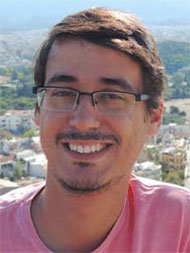
The Brazilian Government has selected Wilton Kort-Kamp [Physics of Condensed Matter and Complex Systems group, T-4) and the Center for Nonlinear Studies (CNLS)] to receive the Coordination for the Improvement of Higher Education Personnel (CAPES) Ph.D. Thesis Award in Physics and Astronomy. CAPES is the highest award in Brazil for a Ph.D. thesis. The President of Brazil will present the award.
Kort-Kamp’s thesis, “Novel Approaches to Tailor and Tune Light-matter Interactions at the Nanoscale,” proposed new, versatile schemes to control light-matter interactions at the nanoscale for both classical and quantum applications. The findings may pave the way for novel, alternative applications involving magneto-optical media, graphene-based materials, and nanostructured materials in disruptive photonic technologies.
Kort-Kamp analyzed the flow of light in situations that do not demand quantization of the electromagnetic field. He examined the physical mechanisms of invisibility cloaks, focusing on devices designed via the scattering cancellation technique. The results showed that a magnetic field could serve as an external agent to tune the operation of the invisibility device. In studies on light-matter interactions mediated by quantum fluctuations of the vacuum electromagnetic field, he obtained expressions to calculate the lifetime of two-level quantum emitters. Kort- Kamp investigated the influence of materials with unusual optical properties on the lifetime of these emitters. His research on near-field heat transfer revealed that heat transfer could be strongly enhanced at the percolation phase transition. The results apply for different effective medium models and are robust against changes in the inclusions' shape and materials.
Kort-Kamp is a Lab postdoctoral research associate. Diego Dalvit (T-4) mentors him in a project to harness light-matter interactions with magneto-optical photonic materials. The Laboratory Directed Research and Development (LDRD) program funds Kort-Kamp’s research. Technical contact: Wilton Kort-Kamp
Ghanshyam Pilania awarded Humboldt Research Foundation Fellowship
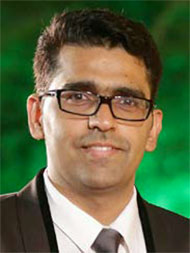
The Alexander von Humboldt Foundation has chosen Ghanshyam Pilania (Materials Science in Radiation and Dynamics Extremes, MST-8) to receive a Humboldt Research Fellowship for Postdoctoral Researchers. As a part of the fellowship, Pilania will visit the Fritz Haber Institute of the Max Planck Society in Berlin, Germany for 12 months to study rational materials design using state-of-the-art materials informatics and data mining techniques. He will develop materials informatics models for complex functional oxides with a particular focus on perovskites and related compounds. These models are of practical interest for a range of applications requiring materials with pre-specified functionalities, including scintillation, photovoltaics, electronic device applications, energy storage, and catalysis.
Pilania received a Ph.D. in Materials Science and Engineering from the University of Connecticut, where he used electronic structure theory to model the ferroelectric and catalytic properties of complex oxides. He received the University of Connecticut’s Materials Science and Engineering Department Outstanding Graduate Student Award. Pilania joined MST-8 as a postdoctoral research fellow in 2013 and received a Director’s Postdoctoral Fellowship in 2014. His postdoctoral research has focused on the development and application of materials modeling tools ranging from electronic- to atomic- to meso-scale, as well as simulations and materials informatics to understand and identify the relationships between the atomic scale structures/processes and the macroscopic behavior and properties of materials. He has authored or co-authored 44 publications in peer-reviewed journals.
The Humboldt foundation grants about 500 fellowships each year to highly qualified researchers who are starting their academic careers. The postdoctoral program allows recipients to spend 6-24 months in Germany on a research program of their choosing. Fellowships are granted on the basis of an applicant’s academic record and performance, the quality of key publications, the originality and innovation potential of the suggested research, and the applicant’s future academic potential. Technical contact: Ghanshyam Pilania
Funsten, Gustavsen, Johnson, Kline, Kress, Simakov, Werner, Zhu named APS Fellows
The American Physics Society (APS) has announced the selection of new Fellows. Eight of them are Los Alamos researchers, as described in the following paragraphs, below.
The American Physical Society is a nonprofit membership organization formed in 1899 to advance and spread the knowledge of physics. The APS represents more than 51,000 members worldwide and publishes more than a dozen scientific journals. Election to Fellow recognizes exceptional contributions to the physics enterprise.
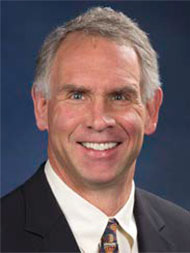
Herbert O. Funsten (Intelligence and Space Research, ISR-DO). The Topical Group in Plasma Astrophysics nominated him. The APS cited Funsten “for pioneering discoveries of the global structure and dynamics of the plasma interaction of the heliosphere with the interstellar medium, and for leadership of the instrumentation that enabled these discoveries.”
Funsten received a Ph.D. in Engineering Physics from the University of Virginia, and then joined the Lab as a postdoc in 1990. He has led science instruments on NASA’s Interstellar Boundary Explorer (IBEX) and Van Allen Probes missions and national security instruments on the DOE’s Space and Atmospheric Burst Reporting System (SABRS) Validation Experiment (SAVE) and SABRS payloads. The IBEX mission first discovered the “ribbon” of neutral atom emission from the Sun’s interaction with the interstellar medium. He has also participated in NASA’s Cassini, Two Wide-angle Imaging Neutral-atom Spectrometers (TWINS), Deep Space 1, Mars Odyssey, and Imager for Magnetopause-to-Aurora Global Exploration (IMAGE) missions. Funsten has received four NASA Group Achievement Awards and four LANL Distinguished Performance Awards. He is a Lab Fellow and has received a Women’s Career Development Award for his mentoring. Technical contact: Herbert Funsten
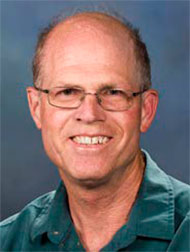
Richard L. Gustavsen (Shock and Detonation Physics, M-9). The Topical Group on Shock Compression of Condensed Matter nominated him. The APS cited Gustavsen “for pioneering studies of the dynamic and high-pressure mechanical and chemical behavior of energetic materials, for shock initiation data used to calibrate reactive burn models, for the development and extension of photon Doppler velocimetry and magnetic particle velocity gauge methods, for mentorship of detonation physicists worldwide, and for leadership and service in the shock physics community.”
Gustavsen received a Ph.D. in Physics from Washington State University. He served as a postdoc at the Institute for Shock Physics, Washington State University, and then joined Los Alamos as a postdoc in the Shock and Detonation Physics group in 1991. Gustavsen became a staff member in 1992. His research includes experimental shock compression physics, shock initiation of solid explosives, reactant and product equations of state for solid explosives, detonation chemical reaction zone measurements, operation of two-stage and single-stage gas guns, magnetic particle velocity gauging, Photonic Doppler Velocimetry (PDV) experiment and analysis, and Isentropic Compression Experiments. He has received three NNSA Awards of Excellence. Technical contact: Richard Gustavsen
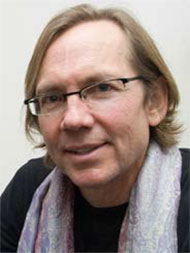
Paul Johnson (Geophysics, EES-17). The APS cited him “for his role in originating and significantly advancing the domain of nonlinear elasticity with a primary focus on earth materials and energy reservoir imaging, and for his role in characterizing dynamical wave interactions on earth faults including fault triggering and dynamically induced memory effects.”
Johnson came to the Lab as a graduate research assistant in 1980. He joined LANL as a staff member in 1984 after earing a Ph.D. in Physical Acoustics from the Université Pierre et Marie Curie at the Sorbonne, Paris. His research includes dynamic triggering of earthquakes and tremor, fault slip characteristics and earthquake physics, seismic strong ground motion and source characteristics, Time Reverse Acoustics and Nonlinearity combined with Time Reversal, applications of nonlinear acoustical nondestructive testing of materials, general acoustics, and rock physics. Johnson is a Fellow of the Acoustical Society of America, American Geophysical Union, Societe Internationale de Mechanique Nonlineaire de Materiaux, and LANL. He has served as a Senior Fulbright Scholar to France and has won the Médaille Étrangère from the Société Française d’Acoustique (French Acoustic Society). Technical contact: Paul Johnson
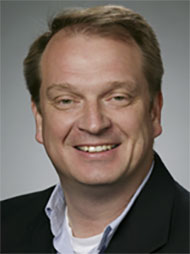
John L. Kline (Plasma Physics, P-24). The Division of Plasma Physics nominated him. The APS cited Kline “for seminal contributions to the understanding and development of hohlraum drivers for inertial confinement fusion and their use for radiation transport, hydrodynamic, and ignition science experiments.”
Kline received a Ph.D. in Plasma Physics from West Virginia University, and then joined Los Alamos as a postdoctoral researcher in 2002. He investigated the physics of laser plasma interactions in the context of inertial confinement fusion (ICF) and the kinetic and the fluid regimes of electron plasma waves driven by stimulated Raman scattering.
In 2008, Kline became actively involved in the national ICF program, first as an experimentalist at the National Ignition Facility (NIF), and later as a campaign leader. He conducted some of the first experiments on the NIF after the initial completion of the facility.
Kline studied hohlraum radiation drive. Now he leads the first campaign to study beryllium capsules for ICF on the NIF, and is a project leader for the LANL ICF program and a team leader for the radiation hydrodynamics team in P-24. Technical contact: John Kline
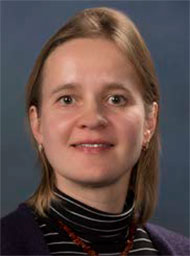
Evgenya Simakov (Accelerators and Electrodynamics, AOT-AE). The Division of Physics of Beams nominated her. The APS cited Simakov “for the development of photonic-band gap accelerating structures.”
Simakov first came to LANL as a visiting graduate student in 2003 from the Massachusetts Institute of Technology (MIT). She received a Ph.D. in Physics from MIT. In 2005, she joined the High-Power Electrodynamics Group as a Director’s Postdoctoral Fellow and in 2007 became a Laboratory staff member. Simakov pioneers development of specially designed structures for high-energy particle accelerators that mitigate undesirable byproducts of high-energy particle acceleration. Her objective is to advance photonic band gap accelerator technology for use in the next generation of particle accelerators for high-energy physics. Superconducting photonic band gap accelerator technology could improve the quality and intensity of accelerated particle beams. This improvement could allow free-electron lasers to deliver extremely intense, short-wavelength laser beams. Simakov has received a Presidential Early Career Award for Scientists and Engineers, a five-year research grant from the DOE’s Office of Science Early Career Research Program, the American Physical Society’s Outstanding Doctoral Thesis Research in Beam Physics Award, and led the Photonics Band Gap Structure team to receive a R&D 100 Finalist Award. She has won two LANL Distinguished Performance Team Awards. Technical contact: Evgenya Simakov
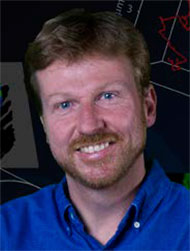
James H. Werner (Center For Integrated Nanotechnologies, MPA-CINT). The Topical Group on Instrument and Measurement Science nominated Werner. The APS cited him “for pioneering contributions to single molecule tracking, optical microscopy, and the development of fluorescent probes for biological imaging and sensing.”
Werner received a Ph.D. in Applied Physics from Cornell University and a Hertz Foundation Fellowship. He started his postdoctoral work at LANL in 1998, becoming a staff member in 2001. Werner’s research focuses on biophysics, optics, nanotechnology, and instrument development. He is an author or co-author on over 60 scientific papers and holds three U.S. Patents. Werner has won R&D 100 Awards for “NanoCluster Beacons” and “3D Tracking Microscope.” The Laboratory has honored him with a Los Alamos Distinguished Patent Award and the Los Alamos Postdoctoral Distinguished Mentor Award. Technical contact: James Werner
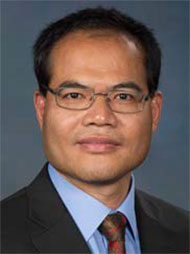
Jian-Xin Zhu (Physics of Condensed Matter and Complex Systems, T-4). The Division of Condensed Matter Physics nominated him. The APS cited Zhu “for outstanding and original contributions to correlated electron systems, specifically electronic structure in unconventional superconductors and heavy fermions.”
Zhu obtained a Ph.D. degree in Theoretical Condensed Matter Physics from the University of Hong Kong. Prior to joining LANL in 2001 as a Director’s Postdoctoral Fellow, he spent four years as a postdoctoral fellow and then as a research assistant professor at the Texas Center for Superconductivity, University of Houston. Zhu became a staff member in T-4. He investigates the impurity problem of strongly correlated electron systems, quantum phase transitions in heavy-fermion systems, and LDA+DMFT electronic structure calculations of strongly correlated electron materials. Zhu is a Partner Science Leader of the Thrust of Theory and Simulation of Nanoscale Phenomena in the Center for Integrated Nanotechnologies (CINT), and an adjunct professor at the University of Houston and at Rice University. He has received a Laboratory Fellows Prize, Small Team LANL Distinguished Performance Award, Postdoctoral Distinguished Performance Award, and the Li Ka-Shing Prize for the best Ph.D. thesis at the University of Hong Kong. Technical contact: Jian-Xin Zhu
Capability Enhancement
Pavel Dub co-authors catalysis book
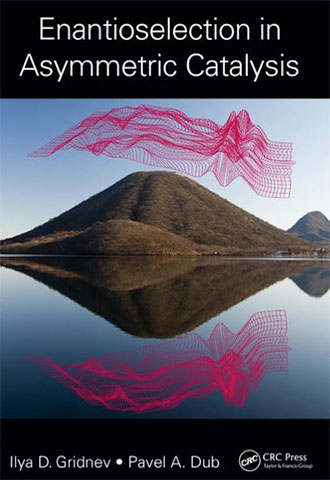
Pavel Dub (Inorganic, Isotope and Actinide Chemistry, C-IIAC) and Ilya Gridnev (Tohoku University, Sendai, Japan) have co-authored a book entitled, “Enantioselection in Asymmetric Catalysis.” The field of asymmetric catalysis is currently one of the hottest areas in chemistry. Enantiomers are molecules that are mirror images of each other and are non-superimposable (called chiral molecules). Life depends on molecular chirality, in that many biological functions are inherently dissymmetric. Most physiological phenomena arise from highly precise molecular interactions in which chiral host molecules recognize two enantiomeric guest molecules in different ways. Enantiomers often smell and taste differently, for example.
The preparation of chiral compounds is an important and challenging area of contemporary synthetic organic chemistry because most natural products are chiral. Their physiological or pharmacological properties depend upon their recognition by chiral receptors, which will interact only with molecules of the proper absolute configuration. The development of new synthetic methods to obtain enantiopure compounds has become a key goal for pharmaceutical companies. The book focuses on the mechanism of enantioselectivity in asymmetric homogeneous catalysis, rather than asymmetric catalysis from the synthetic view.
The book describes reliable, experimentally and computationally supported mechanisms of several important asymmetric reactions catalyzed by transition metal and organo-molecular catalysts. It discusses the danger of so-called “plausible” or “accepted” mechanisms leading to wrong conclusions (e.g., the major/minor concept in rhodiumcatalyzed asymmetric hydrogenation of olefins, or the Noyori mechanism in ruthenium-catalyzed asymmetric hydrogenation of ketones). The book draws parallels to enzymatic catalysis in biochemistry and examines in detail the physico-chemical aspects of enantioselective catalysis. Innovative visualization includes computed structures of the intermediates and transition states, and animated transformations. The publication also presents the intra- and intermolecular interactions that result in asymmetric induction.
Reference: “Enantioselection in Asymmetric Catalysis,” CRC Press (Taylor & Francis Group), ISBN 9781498726542 (2016). Co-authors: Ilya Gridnev and Pavel Dub.
J. Robert Oppenheimer Fellowship funded Dub. The work supports the Lab’s Energy Security mission area and the Materials for the Future science pillar. Technical contact: Pavel Dub
Chemistry
Method developed to scale up the size of quantum-dot solar windows
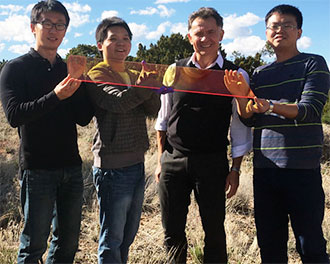
Photo. Researchers hold a large prototype solar window. (Left to right): Jaehoon Lim, Kaifeng Wu, Victor Klimov, and Hongbo Li.
The Lab’s Center for Advanced Solar Photophysics (CASP) is developing quantum-dot based luminescent solar concentrators. The concentrators will harvest sunlight from building windows and convert it into electricity. The journal Nature Energy published a paper in which the CASP team describes an important technological step in taking their solar windows from the laboratory to the construction site. The researchers demonstrated that the window fabrication could be scaled from palm-sized laboratory demonstration models to windows large enough for a building.
Luminescent solar concentrators are light-management devices that could serve as large-area sunlight collectors for photovoltaic cells. A luminescent solar concentrator consists of a slab of transparent glass or plastic impregnated or coated with highly emissive fluorophores. Following absorption of solar light impinging onto a larger-area face of the slab, luminescent solar concentrator fluorophores re-emit photons at a lower energy. Total internal reflection guides these photons to the device edges where photovoltaics collect them. If the cost of luminescent solar concentrators is much lower than that of a photovoltaic cell of a comparable area, and the luminescent solar concentrators’ efficiency is sufficiently high, then it would be possible to achieve a considerable reduction in the cost of producing solar electricity. Semitransparent luminescent solar concentrators might enable solar or photovoltaic windows that could turn presently passive building facades into power generation units.
The solar concentrators use colloidal quantum dots to collect light because quantum dot have properties such as widely tunable absorption and emission spectra, nearly ideal (approximately 100 %) emission efficiencies, and high photostability in sunlight. Quantum dots used in this study are semiconductor spheres with a core of one material and a shell of another. Their absorption and emission spectra can be tuned almost independently by varying the size and/or composition of the core and the shell. The tunability allows the emission spectrum to be controlled by the parameters of the quantum dot core to below the onset of strong optical absorption, which is itself controlled by the parameters of the quantum dot shell. As a result, loss of light due to self-absorption is greatly reduced. This key property of these specially designed quantum dots enables record-size, high-performance luminescent solar concentrator devices.
In the Nature Energy paper, the team created large luminescent solar concentrator windows via the “doctor-blade” technique for depositing thin layers of a quantum dot/polymer composite on top of commercial large-area glass slabs. The “doctor-blade” technique comes from the world of printing. A blade wipes excess liquid material such as ink from a surface, leaving a thin highly uniform film. Researchers have designed the quantum dots used in luminescent solar concentrator devices for optimal performance as luminescent solar concentrators fluorophores and to exhibit good compatibility with the polymer material that holds them on the surface of the window. The team has demonstrated low-loss, large-area (up to about 90 × 30 cm2) luminescent solar concentrators fabricated from colloidal core/shell quantum dots whose optical spectra are tailored to minimize self-absorption of waveguided radiation. The researchers encapsulated the quantum dots in silica shells to improve compatibility with a polymer matrix and enhance stability. This step enables maintenance of high emission efficiencies (approximately 70% quantum yields) under four-month exposure to air and light and heat treatments up to 200 ∘C. The fabricated semi-transparent devices exhibit internal quantum efficiencies of more than 10% for dimensions of tens of centimeters.
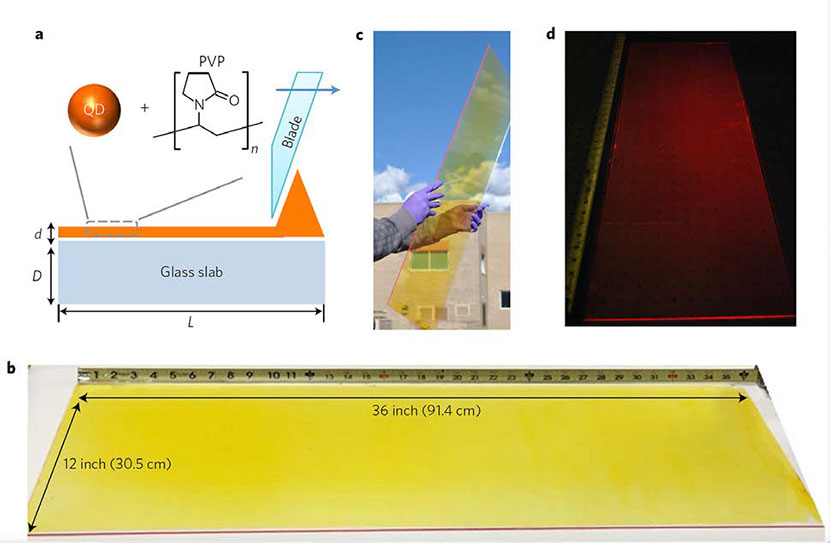
Figure 2. Fabrication of thin-film luminescent solar concentrators via a doctor-blade technique. (a) A schematic representation of thin-film deposition using a doctor-blade method. A quantum dot slurry is placed behind the instrument blade and spread onto the glass slab by laterally moving the blade over the substrate. (b) Photograph of a large-area luminescent solar concentrator fabricated by the doctor-blade method with dimensions 91.4×30.5 cm2 (36×12 in2). (c and d) Luminescent solar concentrators as in ‘b’ under sunlight (in ‘c’) and weak UV illumination (in ‘d’). Brightly lit device edges demonstrate high emissivity and strong waveguiding.
Reference: “Doctor-blade Deposition of Quantum Dots onto Standard Window Glass for Low- Loss Large-Area Luminescent Solar Concentrators,” Nature Energy 1, 16157 (2016); doi:10.1038/nenergy.2016.157. Authors: Hongbo Li, Kaifeng Wu, Jaehoon Lim, Hyung-Jun Song, and Victor I. Klimov (Physical Chemistry and Applied Spectroscopy, C-PCS).
The DOE’s Office of Science, Basic Energy Sciences program through a grant to the Center for Advance Solar Photophysics funded the work. The research supports the Lab’s Energy Security mission area and the Materials for the Future science pillar by developing materials for solar energy harvesting and clean energy generation. Technical contact: Victor Klimov
Educational Outreach
International Academy for Women of the Americas tours LANSCE
The Innovation Academy for Women of the Americas is a first-of-its-kind program bringing together undergraduate student women from New Mexico and Mexico majoring in the fields of science, technology, engineering, mathematics, or architecture (STEM+A). Nearly 30 members of the Academy toured the Los Alamos Neutron Science Center (LANSCE). The tour was part of a month-long course of intensive research, career mentoring, and leadership training in a partnership between the University of New Mexico, Universidad La Salle México, and Universidad Autónoma de Yucatán.
Eva Birnbaum (Science Program Office-Office of Science, SPO-SC) and Anna Llobet (Neutron Science and Technology, P-23) served a Lab hosts. Llobet also gave the keynote talk at the program’s closing ceremony in Albuquerque. The group met with Los Alamos researchers as they toured LANSCE’s Isotope Production and Proton Radiography facilities and learned about astrophysics and LANL contributions to the High-Altitude Water Cherenkov Observatory (HAWC). The observatory, located at 13,500 feet on the slopes of Mexico’s Sierra Negra, is a joint collaboration between the U.S. and Mexico. The day included a lunch-time with discussion with Birnbaum, Llobet, Mary Hockaday (Experimental Physical Sciences, ADEPS), Verena Geppert-Kleinrath and Andrea Albert (P-23), Ann Junghans (Engineered Materials, MST-7), and Rex Hjelm (Materials Science in Radiation and Dynamics Extremes, MST-8).
The Academy is supported by a grant from 100,000 Strong in the Americas, a public-private collaboration of the White House, U.S. Department of State, Partners of the Americas, and NAFSA: Association of International Educators. The Academy aims to: 1) increase bidirectional student mobility between the United States, Mexico, and the Americas through an innovative academic and career development program for underrepresented, minority, and indigenous women in the STEM+A fields; 2) increase the preparedness and representation of women in STEM+A higher-level research and senior leadership roles in the workforce; 3) provide support for women in the STEM+A fields through ongoing web-based forums and mentorship designed to provide encouragement and individualized, meaningful guidance; and 4) discover and leverage ways institutions can collaborate in the STEM+A field over long periods of time. Technical contact: Anna Llobet
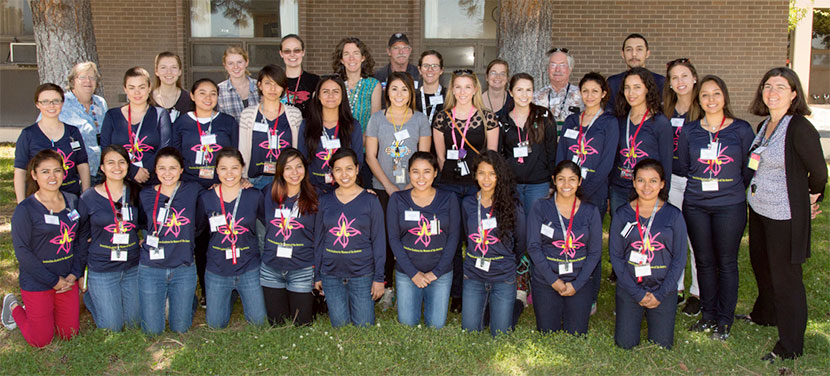
Photo. Women of Americas tour of LANSCE.
Explosive Science and Shock Physics
Quantifying detonation conditions upon high velocity fragment impact
Quantifying detonation conditions upon high velocity fragment impact Hyper-velocity metal fragments driven by a high explosive detonation can pose a significant safety threat during component testing and assembly/disassembly. A new partnership between LANL and Sandia National Laboratories (SNL) researchers is studying this risk. The team investigated fragment-induced detonation of a plastic-bonded explosive (PBX) in a standoff (non-contact) configuration using devices that shock aluminum sheet metal into fragments when initiated. This type of scenario is critical for determining safety procedures for personnel operating in and around high explosive areas or when handling PBX materials.
High-speed video of experiments at LANL detected large, fast moving aluminum fragments, which initiate PBX. The preliminary studies showed that the distance the fragments traveled during the experiment determined whether the PBX pellet detonated. The size and/or concentration of the fragments played some role. Different shock configurations generated different fragment fields. For example, sometimes a single large fragment would travel ahead of the main field; at other times multiple fragments traveled adjacent to each other.
Sandia used their unique digital in-line holography (DIH) diagnostic for detailed quantification of these fragments. The diagnostic characterized the generated fragments, finding them to be hundreds of microns in diameter and traveling at several km/s at the point of impact even after traveling several inches through the air. Fragments at this size and velocity could initiate certain PBX materials.
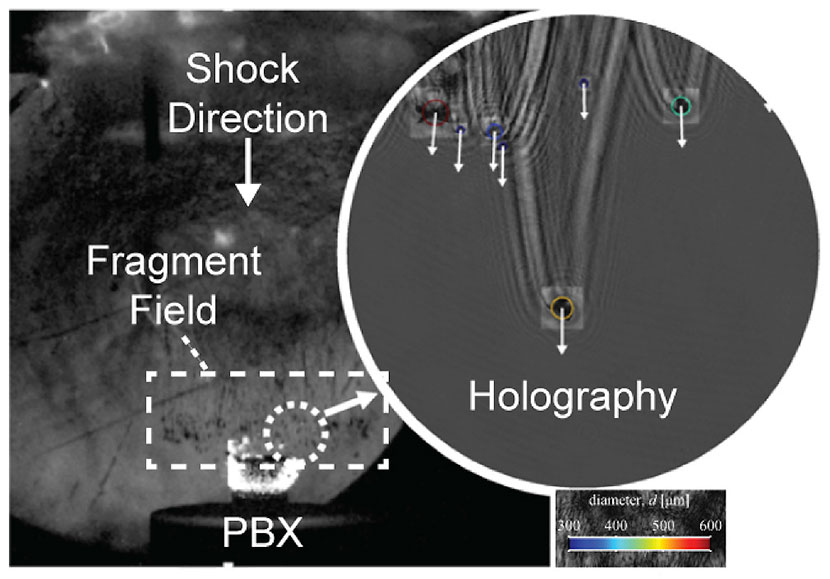
Figure 4. Still frame from a high-‐speed video experiment (left) shows a shock-‐generated fragment field impacting and detonating a PBX material. Holography (right) was used to characterize fragment size and velocity.
These are the first-ever three-dimensional, holographic recordings of fragment size-velocity correlations in such an environment. The data will be vital for future experiments and for hydrocode simulations to quantify shock-to-detonation transition mechanisms and the associated risk-margins for these materials. The combination of LANL and Sandia expertise developed new methodologies for detailed investigation of risk-margins and continuous safety improvement during component testing and assembly.
Researchers include John Yeager and Patrick Bowden (High Explosive Science and Technology, M-7), Daniel Guildenbecher and Joseph Olles (Sandia National Laboratories).
The DOE Nuclear Safety Research and Development Program and the Joint Munitions Program funded the research, which supports LANL’s Nuclear Deterrence and Global Security mission areas and the Materials for the Future and Science of Signatures science pillars. Technical contact: John Yeager
Intelligence and Space Research
Unraveling cross-energy coupling in the Earth’s radiation belts with SHIELDS
Understanding the physical processes that control the dynamics of energetic electrons in the inner magnetosphere (the region of space dominated by the Earth’s magnetic field) is important for the protection of near-Earth orbiting satellites. Accurately modeling and predicting electron fluxes that could cause hazardous space weather events is challenging because the near-Earth system is strongly coupled. A project funded through the Laboratory Directed Research and Development (LDRD) program aims to develop a new capability to understand, model, and predict Space Hazards Induced near Earth by Large Dynamic Storms, the SHIELDS framework (http://www.lanl.gov/projects/shields/). Scientists from the SHIELDS team and collaborators studied the temporal and spatial evolution of relativistic electrons observed during storm time by NASA’s Van Allen Probes. They compared the data with their model and published their findings in the Journal of Geophysical Research – Space Physics.
Electron fluxes that intensify during storm time could damage satellites in two important ways: 1) lower-energy (keV) electrons cause surface charging and potential differences that can harm electronics, and 2) higher-energy (above 1 MeV) electrons can penetrate the surface and cause deep-dielectric charging and component failures. Dominant mechanisms for electron acceleration are radial transport from an outside source or local acceleration by plasma waves. Major loss mechanisms are drift through the outer boundary (the magnetopause) or particle precipitation into the Earth’s atmosphere. How these competing acceleration and loss processes operate to produce the relativistic electron populations is a long-standing problem in space research.
NASA launched the Van Allen Probes mission (previously known as the Radiation Belt Storm Probes, RBSP) to investigate the storm time dynamics of relativistic electrons and to aid the development of models for specification and prediction of space weather effects. The mission carries two LANL-designed instruments that measure the near-Earth particle fluxes and their variation in response to solar wind driving conditions. Lab researchers and collaborators examined the data collected during storm time.
The team investigated the mechanisms for electron injection, trapping, and loss with the Ring current-Atmosphere interactions Model (RAM-SCB) developed at LANL and part of the SHIELDS framework. Researchers included plasma wave scattering for the first time in RAMSCB using radial and magnetic local time dependent event-specific plasma wave models inferred from National Oceanic and Atmospheric Administration (NOAA) Polar-orbiting Operational Environmental Satellites (POES) and Van Allen Probes observations. The investigators compared the dynamics of the source (tens of keV) and seed (hundreds of keV) populations of the radiation belts simulated with RAM-SCB, with Van Allen Probes observations and measurements from the NOAA-15 satellite. The team discovered that the low-energy (less than 100 keV) electron fluxes increased significantly by convective transport during the storm main phase and decreased during the intermediate recovery phase. These findings agreed with observations. However, this mechanism underestimated the injection of high-energy electrons throughout the storm. Local acceleration by plasma waves intensified the electron fluxes at energies greater than 50 keV considerably, and RAM-SCB simulations overestimated the observed trapped fluxes by more than an order of magnitude. The simulated with RAM-SCB precipitating fluxes were weaker, and their temporal and spatial evolution agreed well with POES data.
The team had not expected that the RAM-SCB model results would reproduce significant electron acceleration by plasma waves at energies as low as 50 keV because the energy diffusion coefficients are much smaller than the pitch angle diffusion coefficients in this energy range (Figure 5). The presence of a large energy anisotropy that developed in the electron phase space distribution after particles were injected from the nightside enhanced this energization effect. These results indicate that either: 1) including additional loss mechanisms (such as enhanced losses through the dayside magnetopause) or 2) taking into account nonlinear effects in plasma wave scattering, are needed to better reproduce the relativistic electron populations of the near-Earth space environment.
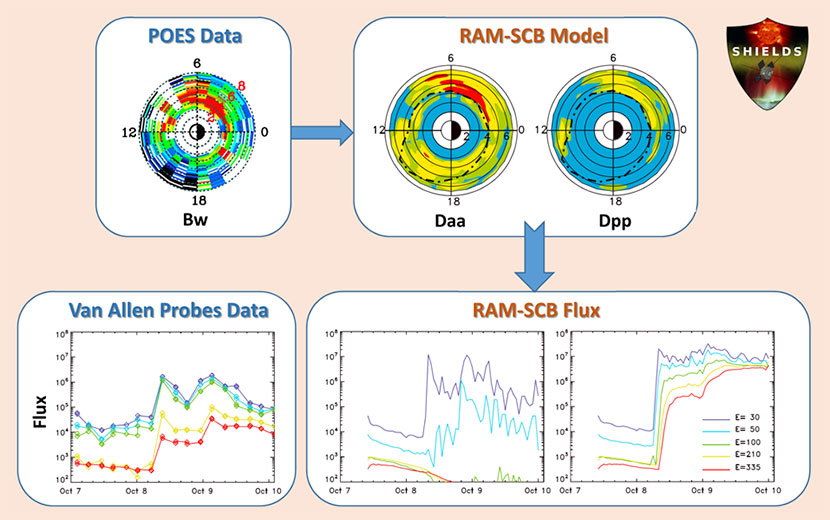
Figure 5. (Top) Schematic representation of SHIELDS/RAM-SCB model driven by event-specific plasma wave models from POES and Van Allen Probes data. (Bottom) Comparison of Van Allen Probes flux data with RAM-SCB simulations (left) without and (right) with local acceleration. Bw-wave amplitude, Daa-pitch angle diffusion coefficient, Dpp-momentum diffusion coefficient.
Reference: “RAM-SCB Simulations of Electron Transport and Plasma Wave Scattering during the October 2012 Double-dip Storm”, Journal of Geophysical Research Space Physics 121, 8712 (2016); doi:10.1002/2016JA022470. Authors: V. K. Jordanova, W. Tu, Y. Chen, S. K. Morley, and G. D. Reeves (Space Science and Applications, ISR-1); A.-D. Panaitescu (Space and Remote Sensing, ISR-2); and C. A. Kletzing (University of Iowa).
The Los Alamos National Laboratory Research and Development (LDRD) Directed Research program and NASA’s Van Allen Probes contract funded different aspects of the research. The RAM-SCB model is part of the SHIELDS framework, which runs on the Lab’s High Performance Computing clusters. This work supports the Lab’s Global Security mission area and the Science of Signatures and Nuclear and Particle Future science pillars through the capability to predict space weather and protect near-Earth orbiting satellites. Technical contact: Vania Jordanova
Materials Physics and Applications
A new class of robust fuel cells based on ion-pair-coordinated polymers
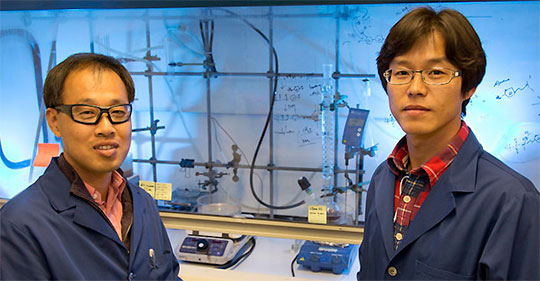
Photo. Yu Seung Kim (left) and Kwan-‐Soo Lee (right) are part of the team that developed the new class of fuel cells.
Polymer-based fuel cells could be a key future clean power generation technology for vehicle and stationary systems. The main classes of polymer-based fuel cells have limitations in operating temperature range and water requirements/tolerance. LANL researchers and collaborators have discovered a material that could bridge the gap between the operating temperature ranges of existing fuel cells. The new fuel cell class is based on material that can be operated between 80 and 200°C with or without water. Nature Energy published the work.
Two main classes of polymer-based fuel cells are currently available, each with their own limitations. 1) Low-temperature fuel cells require water for proton conduction, providing a 100°C upper limit of operating temperature. 2) High-temperature fuel cells can operate up to 180°C without water. However, the high-temperature fuel cells degrade under water-absorbing conditions below 140°C.
Running fuel cells at a wide operating temperature range with water tolerance would be a huge benefit. Current fuel cell vehicles need humidified inlet streams and large radiators to dissipate waste heat, which increase the fuel cell system cost substantially. Therefore, researchers have sought materials that can conduct protons under the flexible operating conditions.
Interactions between the acid and the base moieties in the polymer electrolytes dictate the operating temperature window of polymer-based fuel cells. The hydrogen bonding interaction between the sulfonic acid group and water molecules in the low-temperature fuel cells (15.4 kcal/mol) does not provide enough stability above water’s boiling point. The weak acid-base interaction between phosphoric acid and polybenzimidazole in high-temperature fuel cells (17.4 kcal/mol) allows loss of phosphoric acid in the presence of water, preventing use of the fuel cells at low temperatures.
The LANL team in collaboration with Yoong-Kee Choe (National Institute of Advanced Industrial Science and Technology, Japan) found that phosphate-quaternary ammonium ion pair has a much stronger interaction ca., 151.7 kcal/mol, and the ion pair can transport protons effectively under water-condensing conditions. The experimental work built on Choe’s calculations that the interaction between quaternary ammonium and biphosphate is 8.7 times stronger than benzimidazole and phosphoric acid.
Based on this finding, the researchers collaborated with Cy Fujimoto (Sandia National Laboratories) to prepare ion-pair-coordinated polyphenylenes. The prototype fuel cells made from the ion-pair-coordinated membrane demonstrated excellent performance and durability at 80-200°C, which is unattainable with existing fuel cell technology. The operational flexibility could enable fuel cell system simplification and cost reduction. This finding might accelerate the commercialization of low-cost fuel cells for automotive and stationary applications.
Reference: “An Operationally Flexible Fuel Cell Based on Quaternary Ammoniumbiphosphate Ion Pairs,” Nature Energy 1, 16120 (2016); doi: 10.1038/nenergY.2016.120. Authors: Kwan-Soo Lee, Jacob Spendelow, and Yu Seung Kim (Materials Synthesis and Integrated Devices, MPA-11); Yoong-Kee Choe (National Institute of Advanced Industrial Science and Technology, Japan), Cy Fujimoto (Sandia National Laboratories).
The DOE Office of Energy Efficiency and Renewable Energy, Fuel Cell Technology Office (LANL Program Manager: Rod Borup) funded the research at Los Alamos, which supports the Lab’s Energy Security mission area and the Materials for the Future science pillar through the development of materials for clean power generation. Technical contact: Yu Seung Kim
Materials Science and Technology
Microstructural effects on damage evolution in shocked polycrystalline materials
Understanding and controlling the mechanisms of dynamic failure of polycrystalline structural materials is an important and mission-critical scientific challenge facing the Laboratory. Most structural metals are aggregates of crystals with irregular shape, anisotropic mechanical properties, and contain a variety of defects, resulting in very complex dynamic mechanical responses. To a large extent, failure models remain empirically calibrated due to a lack of a thorough understanding of the controlling processes at the scale of the material heterogeneity. Laboratory researchers and collaborators have used three-dimensional (3-D) characterization techniques and micromechanical modeling to examine microstructural effects on damage evolution in shocked materials. The journal Acta Materialia published the results.
An important failure mechanism for ductile materials undergoing dynamic loading conditions is void nucleation, growth, and coalescence. The ability to predict the extent to which a given microstructure is vulnerable to damage nucleation and growth is relevant to the emerging field of computational materials design, to enable the discovery and development of new processes and/or materials with higher resistance to damage. The determination of whether or not voids will nucleate and grow in specific locations requires identifying which microstructural features promote or inhibit damage initiation. Identifying potential microstructural features that influence damage necessitates knowledge of where damage develops within a microstructure under certain mechanical loading, and what is the micromechanical response at those locations.
Ricardo Lebensohn (Materials Science in Radiation and Dynamics Extremes, MST-8), Curt Bronkhorst (Fluid Dynamics and Solid Mechanics, T-3), Carnegie-Mellon University professor Tony Rollett, and students Evan Lieberman and David Menasche, used 3-D crystallographic orientation field and the void locations in an incipiently-spalled copper sample (Figure 6b) characterized before and after shock (Figure 6a) by near-field high energy diffraction microscopy (nf-HEDM) to study damage evolution. Carnegie-Mellon University collaborators pioneered the HEDM technique at Argonne National Laboratory’s Advanced Photon Source.
The locations of the voids, predominantly found near grain boundaries (Figure 6d), were traced back and registered to the pre-shocked microstructural image (Figure 6c). The team used the Lab’s fast Fourier transform (FFT)-based formulation with direct input from the measured microstructure to determine the micromechanical fields at the shock peak stress. Researchers compared statistical distributions of these fields restricted to grain boundary locations that developed voids after the shock, with corresponding distributions for all grain boundaries. The analysis revealed that the most significant correlation between damage and microstructure corresponds to grain boundaries adjacent to crystals having very different plastic response (Figure 6e). Accounting for this correlation, learned from a combination of micromechanical experiments and modeling, will aid the design of more damage-tolerant materials via microstructure manipulation.
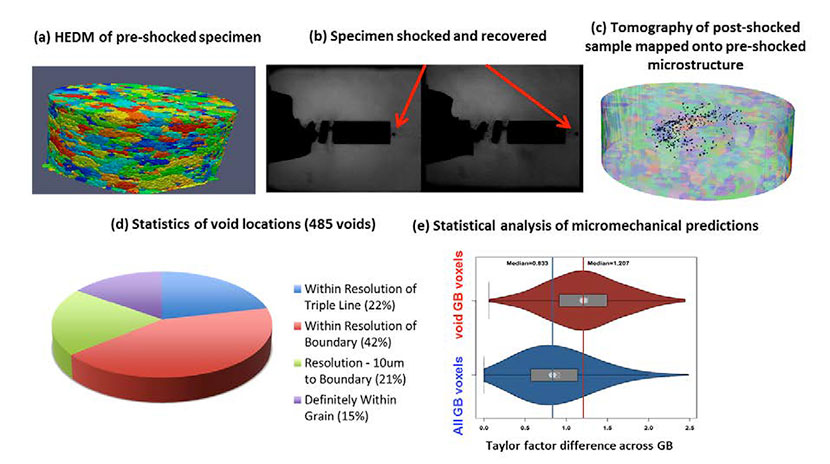
Figure 6. Three-dimensional crystal orientation fields of a copper sample, characterized before and after shock loading using High Energy Diffraction Microscopy (HEDM), are used for input and validation of direct numerical simulations using a Fast Fourier Transform (FFT)-based micromechanical model. The locations of the voids determined by x-ray tomography in the incipiently-spalled sample, predominantly found near grain boundaries, were traced back and registered to the pre-shocked microstructural image.
Reference: “Microstructural Effects on Damage Evolution in Shocked Copper Polycrystals,” Acta Materialia 116, 270 (2016); doi: 10.1016/j.actamat.2016.06.054. Authors: E. Lieberman (Carnegie Mellon University and MST-8), R. A. Lebensohn (MST-8), C. A. Bronkhorst (T-3), D. B. Menasche and A.D. Rollett (Carnegie-Mellon University)
The Laboratory Directed Research and Development (LDRD) program funded Lebensohn and Lieberman, and the Joint DoD/DOE Munitions Technology Program funded Bronkhorst. The work supports the Laboratory’s Nuclear Deterrence and Global Security mission areas and the Materials for the Future science pillar. Technical contact: Ricardo Lebensohn
Physics
TRIDENT enables application of a laser-driven intense pulsed neutron source
An international team of researchers supported a final campaign to use the TRIDENT laser to produce neutrons. They experimentally assessed whether laser-driven neutron sources could be useful for MaRIE (Matter-Radiation Interactions in Extremes), the Laboratory’s proposed experimental facility for time-dependent materials science at the mesoscale. Neutrons provide a radiographic probe that is complementary to x-rays and protons, and could address imaging challenges not amenable to those beams. The work demonstrates LANL’s responsiveness, flexibility, and ability to apply diverse expertise to perform complex experiments.
The team aimed to characterize the laser-driven neutrons and demonstrate various applications from the experiments. Lab researchers installed detectors at TRIDENT that had been developed and are used at LANSCE. Detector panels from the High Pressure-Preferred Orientation (HIPPO) neutron diffractometer collected thermal diffraction spectra, a thermal/epithermal neutron time-of-flight imaging detector measured data for neutron absorption resonances and Bragg-edges, and a high-energy neutron-imaging detector made measurements. These detector systems, which are normally used at the Los Alamos Neutron Science Center (LANSCE) beam lines, added substantial value to the TRIDENT campaign. Such specialized detector systems would be otherwise unavailable. The investigators moderated the neutron source for many of the shots to assess the ability to produce thermal and epithermal neutrons.
Figure 7 shows a fast neutron radiograph of various objects, selected to assess resolution and discriminate contributions from neutron and gamma radiation. A single TRIDENT laser pulse produced neutrons and gammas for the radiograph. Initial analysis of attenuation by a six-step polyethylene wedge, which attenuates neutrons far more than gamma rays, indicates that the image originates predominantly from neutrons. The line pair gauge, which was not well aligned, showed resolution better than 2 mm. Both the detector configuration and the geometry could be optimized for better resolution in future work. The picture quality surprised the team because it surpassed their previous results acquired at TRIDENT. This quality may be sufficient for some applications such as static high energy x-ray or neutron radiography and tomography, or single shot flash radiography. LANSCE had demonstrated previously the high penetrating power of energetic neutrons, and laser-driven sources show the potential for compact energetic neutron sources.
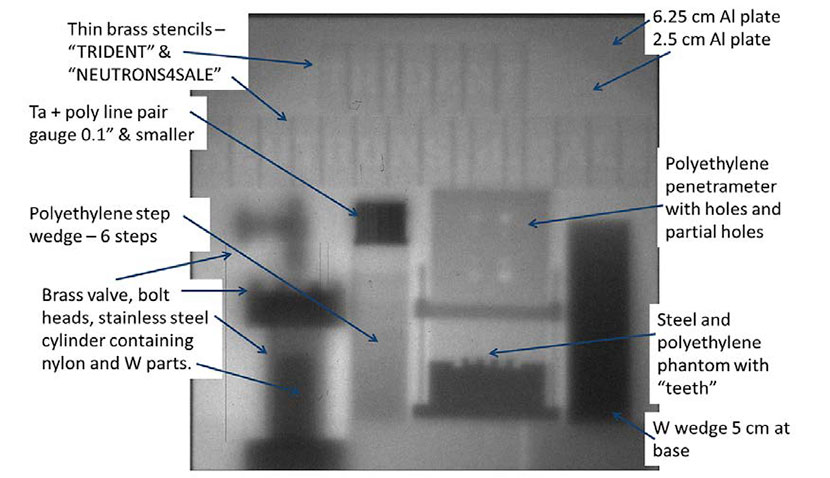
Figure 7. Radiograph from a single TRIDENT shot viewing several objects. The objects chosen for this test reveal the resolution as well as the fraction of neutron versus gamma radiation detected by the imaging system. Initial analysis, e.g. of the image of the polyethylene step wedge, indicates that the detected signal originates predominantly from neutrons. The spatial resolution could be improved with changes in both the neutron converter screen in the detector and the geometry. The line pair gauge shows better than 2-‐mm resolution.
The LANSCE thermal/epithermal energy-resolved imaging detector revealed resonances from an indium foil in single pulses. The result might allow measurement of the temperature in bulk materials from resonance broadening, as demonstrated at the approximately 1,000 times more intense LANSCE neutron source a decade ago. This technique could provide a unique diagnostic tool for MaRIE.
The team suggests that intense short laser pulses could be used to accelerate ions to energies sufficient for fast neutron production, providing focused, short pulse (less than 60 ns) neutrons for applications. Such sources complement and might someday replace or even surpass large, expensive linear accelerators. The compactness and smaller energy requirement of lasers (compared with linear accelerators) might enable a compact pulsed neutron source to be deployed on a truck. Moreover, the forward directed emission of neutrons reduces the radiation shielding needed, and the short pulses might enable flash neutron radiography.
Because the investment cost of lasers is at least one order of magnitude lower than a linear accelerator, several lasers could be combined to make a neutron source of higher emittance than today’s most powerful neutron sources. Combining several synchronized laser-driven neutron-producing targets into a single intense neutron source could circumvent thermal problems of present neutron sources, enabling new neutron production target designs. For MaRIE, several intense laser-driven neutron sources could generate sub-microsecond spaced neutron pulses to characterize different sample volumes at different times during a dynamic event, providing temperature and microstructure information from neutron absorption resonance broadening and Bragg-edges, respectively.
The Lab’s Roadrunner supercomputer predicted some of the physical effects occurring during the interaction of the laser pulse with the target material that could boost neutron production, and TRIDENT experimentally verified them. The unique combination of experimental and theoretical laser and laser-plasma expertise, plus neutron expertise at LANSCE, makes LANL a unique place to develop laser-driven pulsed neutron sources.
The international research team included: Campaign Principal Investigator and LANSCE Rosen Scholar Professor Markus Roth (Technical University, Darmstadt, Germany) and team (Annika Kleinschmidt, Alexandra Tebartz, Victor Schanz, Gabriel Schaumann), the TRIDENT-based team (Cort Gautier, Randy Johnson, Russ Mortensen, Tom Shimada, Sasi Palaniyappan, and Glen Wurden (Plasma Physics, P-24), Andrea Favalli (Safeguards Science and Technology, NEN-1), Sven Vogel (Materials Science in Radiation and Dynamics Extremes, MST-8), Ron Nelson (LANSCE Weapons Physics, P-27), Michelle Espy and James Hunter (Applied Engineering Technology AET-6), Adrian Losko (University of California – Berkeley, postdoc affiliate in MST-8), Tel Aviv University (Ishay Pomarantz and Itay Kishon), and Dresden Helmholtz-Zentrum Dresden-Rossendorf Laboratory (Anna Ferrari, Fondazione Cnao, and Alejandro Garcia-Laso).
MST-8, P-27, and AET-6 were funded to assess whether laser-driven neutron sources could be used for MaRIE (LANL Capture Manager, Cris Barnes). Enhanced Surveillance, Nuclear Energy, and a Lab capability development grant funded neutron imaging detector development. Upon TRIDENT laser closure, research will continue at the German PHELIX laser system. The work supports the Lab’s Nuclear Deterrence and Global Security mission areas and the Science of Signatures and Nuclear and Particle Futures science pillars. Technical contact: Sven Vogel
Sigma
High density polycrystalline ceramics for high voltage opening switch applications
Los Alamos researchers and collaborators have produced a high-density polycrystalline lithium tantalum oxide (LiTaO3) ferroelectric ceramic that is immune to cracking. This achievement overcomes a technical hurdle limiting the material’s use in current-drive technology applications. The Journal of Materials Science: Materials in Electronics published the work.
Voltage-driven technology has dominated fast, high-voltage pulsed power systems for the past 60 years. Current-driven technology has 10,000-fold higher energy density than voltage-driven technology and also has other substantial advantages. However, industry has never been able to make an effective opening switch, which is essential for the use of current-driven technology.
LiTaO3 are prototypic ferroelectrics, useful for a large number of applications due to their large spontaneous polarizations and strong pyroelectric and electro-optic responses. Recent research has indicated that LiTaO3 is an ideal material for the ferroelectric opening switch. Single crystal LiTaO3 has a square cornered polarization-electric field loop, which yields the greatest contrast between the impedance of the switch in the unsaturated and saturated states. LiTaO3 ferroelectric ceramics could be used for LANL’s Dual Axis Radiographic Hydrodynamic Test (DARHT) Facility, Sandia National Laboratories’ Z-Machine, and for other high voltage opening switch applications.
Fully dense, pure polycrystalline LiTaO3 ceramics have never been achieved due to its trigonal (rhombohedral) crystal structure with significant crystallographic anisotropy in coefficients of thermal expansion. These properties lead to tremendous stresses during cooling of a consolidated body.
Researchers from Los Alamos, Sandia National Laboratories, and Colorado School of Mines have produced high-density (99.9%) polycrystalline LiTaO3. The keys to the high density without cracking were: 1) the use of lithium fluoride-assisted densification to maintain fine grain size, and 2) the presence of secondary lithium aluminate phases as grain growth inhibitors. The average grain size of the hot pressed polycrystalline LiTaO3 is less than 5 μm, limiting residual stresses caused by the anisotropic thermal expansion. Efficient liquid phase sintering allows densification during low temperature hot pressing. Transmission electron microscopy performed at LANL’s Electron Microscopy Laboratory confirmed the high-density microstructure.

Figure 8. (Left): Electron backscattering scanning diffraction micrograph reveals that the average grain size of the hot pressed polycrystalline LiTaO3 is less than 5 μm. (Right): Transmission electron micrograph image shows that the efficient liquid phase sintering allows densification during low temperature hot pressing.
Reference: “Processing of Crack-Free High Density Polycrystalline LiTaO3 Ceramics.” Journal of Materials Science: Materials in Electronics (2016); doi: 10.1007/s10854-016- 5980-5. Authors: Ching-Fong (Chris) Chen and Eric L. Tegtmeier (Sigma Division, SIGMADO), Terry Holesinger (Nuclear Materials Science, MST-16), Graham King (formerly LANL), Geoff L. Brennecka and Jacob Ivy (Colorado School of Mines), and Pin Yang (Sandia National Laboratories).
The NNSA Science Campaign 3 (LANL Program Manager Robert Reinovsky) funded the work, which supports LANL’s Nuclear Deterrence and Energy Security mission areas and the Materials for the Future science pillar. Technical contact: Chris Chen
















